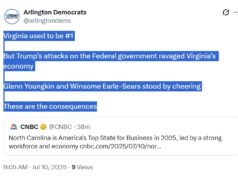Ordinarily, I don’t go public with such an early draft of a piece as this. I expect that a more polished version will be in newspapers out here in the Shenandoah Valley next week. But somehow, with this one, it feels better not to wait to share it now with this readership. It’s Saturday, it relates to the stuff we’ve all been talking about for the past week, and it relates to the paramount electoral contest here in Virginia in this election year.
So for all those reasons, here’s what I’ve drafted today.
******************
The Republicans have apparently made a very smart decision. In the wake of the difficulties the Party faced after President Trump’s equivocations regarding the white supremacist and neo-Nazi rally in Charlottesville, they have figured out a way to shift the conversation to their advantage: rather than talking about white supremacy, much better to talk about the controversy over Confederate monuments.
That’s a smart move because, although only a small minority of Americans respond favorably to a defense of white supremacy, a recent poll shows that 62 percent of Americans support keeping statues honoring leaders of the Confederacy as historical symbols. That issue, therefore, puts people like Ed Gillespie – the Republican candidate for Virginia’s governorship – in an advantageous position re his Democratic opponent, Ralph Northam, who backs their removal.
But this move is like a lot of other smart electoral moves the Republicans have made in recent years: though clever, it also is founded on falsehood.
The argument that our history should be acknowledged and not erased is a compelling one. But the problem is, what these statues represent is not our real history, but a distortion of it. The picture of history they represent is false in two ways.
First, they are an expression of a myth about the Confederacy — that arose quickly after the Civil War — according to which the Confederacy fought for noble ideals. But – as journalist Tracy Thompson, born and raised in Atlanta, reports: among scholars who study the war, though on many things they disagree, on one point they agree: for the South, the issue of slavery was “the root of everything.”
The men who fought for the Confederacy fought for the preservation of slavery—as the declarations from the various states as they seceded and formed the Confederacy made quite clear. Even if they denied it six years later. (Google: McPherson, nyrb.com, civil war.)
The second falsehood – or rather, only very partial truth — is that impulse behind the erection of all these monuments was one of honoring the past heroes of the Confederacy. It was that, but it was something else, too—something darker.
The actual history of the appearance of these monuments adds another important – and rather darker, animated by the spirit of racial superiority – to the story.
It was nearly two generations removed from the Civil War that these monuments went up. It was a time of a powerful reassertion of white dominance in the South. The last decade of the 19th century and the first decade of twentieth century was a time when black people were not only denied the right to vote, but were being lynched by the hundreds. (Mostly black men, but also women and children.)
Domination by terror. Domination by law. Humiliation and torture made part of a people’s experience.
It was in that context that many Confederate monuments were erected and placed in public squares and near courthouses—conveying a “very pointed statement about the rule of white supremacy.” The monument declares, in the words of journalist Ida B. Wells: “All who enter the courthouse are subject to the laws of white men.”
In other words, in the perspective of the true history, shifting the topic from white supremacy to Civil War monuments is not changing the subject at all. The subject is still white supremacy, only now it is hidden behind some venerable falsehoods.
But the move is no less smart for that. The false picture, and those who use it, have the advantage in two ways.
First, it’s a simple picture and can be conveyed in a sentence. The South had this noble Lost Cause, and those who erected and those who support their place in the landscape simply want to honor their heritage. It’s not about race.
By contrast, the true picture is more complex. Conveying that picture requires providing people some understanding of the role these monuments have played in the system of racial suppression.
The other disadvantage the truth has here is that it runs up against lies that have been disseminated in American culture for well over a century. In the South in particular, teachers and professors could lose their jobs if they taught history as the historians knew it instead of as the dominant powers in society composed it. (google…)
According to a poll conducted by the Pew Research Center in 2011, while 38% of Americans agreed with the virtually unanimous opinion of the experts that the South fought to defend slavery, 48% believed it was for other, non-racist reasons.
The story of how Southern revisionists managed to make their version of history the dominant one is an interesting one. But all that need be said here is that the success of these historical falsehoods over generations has the effect in today’s political contests of putting a wind at the back of those eager to use the issue of Confederate monuments to get themselves elected.
A candidate like Northam has truth and righteousness on his side on this issue. But if I were he, I would not be eager to have the campaign focus on it. It is very hard for a candidate to educate the voting public about anything the least bit complex. And people will respond to Gillespie’s version because Northam’s more valid case will be harder to make.
What matters most, however, is not the monuments themselves, many of which are quite beautiful and inspiring as heroic figures. (I think the statue they’re fighting over in Charlottesville is splendid.) What matters is whether Americans are willing to understand what they signify in terms of the relationship between the races in America – both historically, and in this present moment.
And what matters is that, understanding that, people are willing to extend empathy and brotherhood to their fellow Americans who have endured a history most painful to endure, made more painful by its being denied.
Clearly, the Christian thing to do is to make sure that the solution to the monuments issue is to find some way of addressing meaningfully the entirely understandable feelings of people who have experienced pain from white supremacy, and who have experienced the real message of these monuments, perceive these monuments.
As you would have them do unto you.












![Video: Democrat James Osyf Announces Campaign for Congress in VA-02; Says “I’ve lived the Silent Service [including during ‘Don’t Ask Don’t Tell’], but this moment demands something different.”](https://bluevirginia.us/wp-content/uploads/2025/07/osyfsilentservice-100x75.jpg)